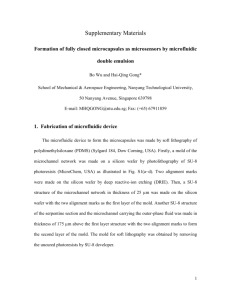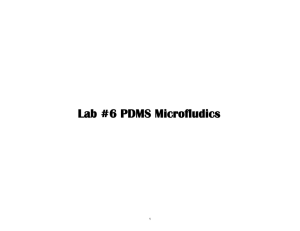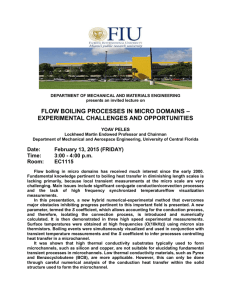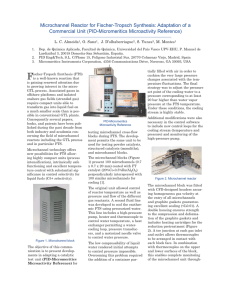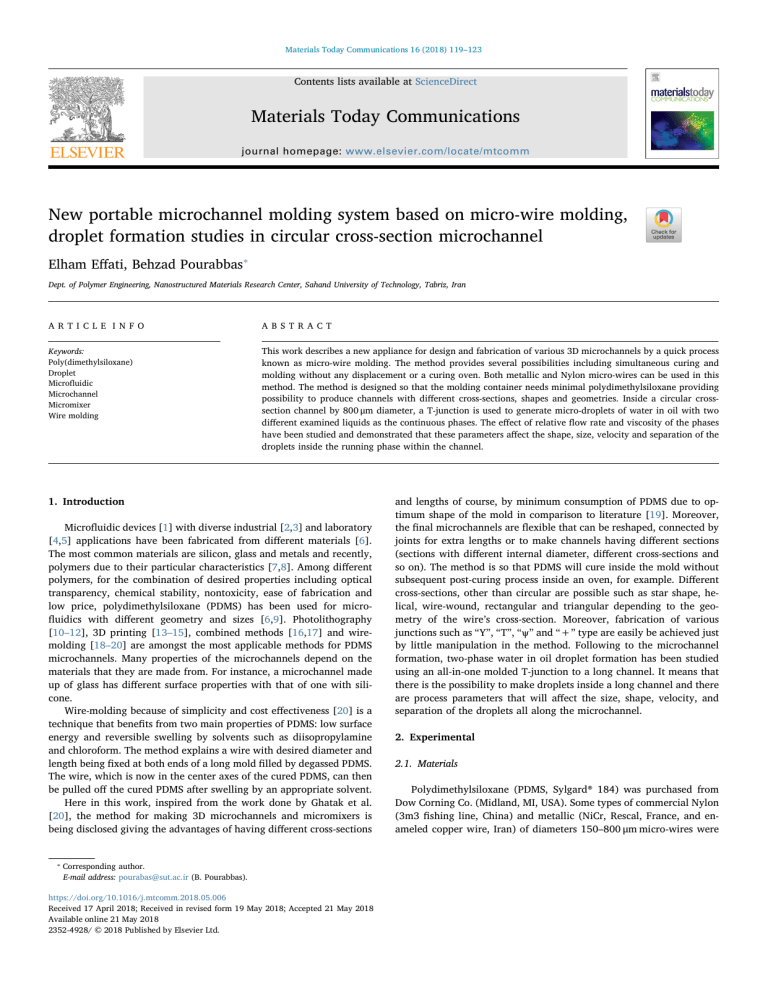
Materials Today Communications 16 (2018) 119–123 Contents lists available at ScienceDirect Materials Today Communications journal homepage: www.elsevier.com/locate/mtcomm New portable microchannel molding system based on micro-wire molding, droplet formation studies in circular cross-section microchannel Elham Effati, Behzad Pourabbas T ⁎ Dept. of Polymer Engineering, Nanostructured Materials Research Center, Sahand University of Technology, Tabriz, Iran A R T I C LE I N FO A B S T R A C T Keywords: Poly(dimethylsiloxane) Droplet Microfluidic Microchannel Micromixer Wire molding This work describes a new appliance for design and fabrication of various 3D microchannels by a quick process known as micro-wire molding. The method provides several possibilities including simultaneous curing and molding without any displacement or a curing oven. Both metallic and Nylon micro-wires can be used in this method. The method is designed so that the molding container needs minimal polydimethylsiloxane providing possibility to produce channels with different cross-sections, shapes and geometries. Inside a circular crosssection channel by 800 μm diameter, a T-junction is used to generate micro-droplets of water in oil with two different examined liquids as the continuous phases. The effect of relative flow rate and viscosity of the phases have been studied and demonstrated that these parameters affect the shape, size, velocity and separation of the droplets inside the running phase within the channel. 1. Introduction Microfluidic devices [1] with diverse industrial [2,3] and laboratory [4,5] applications have been fabricated from different materials [6]. The most common materials are silicon, glass and metals and recently, polymers due to their particular characteristics [7,8]. Among different polymers, for the combination of desired properties including optical transparency, chemical stability, nontoxicity, ease of fabrication and low price, polydimethylsiloxane (PDMS) has been used for microfluidics with different geometry and sizes [6,9]. Photolithography [10–12], 3D printing [13–15], combined methods [16,17] and wiremolding [18–20] are amongst the most applicable methods for PDMS microchannels. Many properties of the microchannels depend on the materials that they are made from. For instance, a microchannel made up of glass has different surface properties with that of one with silicone. Wire-molding because of simplicity and cost effectiveness [20] is a technique that benefits from two main properties of PDMS: low surface energy and reversible swelling by solvents such as diisopropylamine and chloroform. The method explains a wire with desired diameter and length being fixed at both ends of a long mold filled by degassed PDMS. The wire, which is now in the center axes of the cured PDMS, can then be pulled off the cured PDMS after swelling by an appropriate solvent. Here in this work, inspired from the work done by Ghatak et al. [20], the method for making 3D microchannels and micromixers is being disclosed giving the advantages of having different cross-sections ⁎ Corresponding author. E-mail address: pourabas@sut.ac.ir (B. Pourabbas). https://doi.org/10.1016/j.mtcomm.2018.05.006 Received 17 April 2018; Received in revised form 19 May 2018; Accepted 21 May 2018 Available online 21 May 2018 2352-4928/ © 2018 Published by Elsevier Ltd. and lengths of course, by minimum consumption of PDMS due to optimum shape of the mold in comparison to literature [19]. Moreover, the final microchannels are flexible that can be reshaped, connected by joints for extra lengths or to make channels having different sections (sections with different internal diameter, different cross-sections and so on). The method is so that PDMS will cure inside the mold without subsequent post-curing process inside an oven, for example. Different cross-sections, other than circular are possible such as star shape, helical, wire-wound, rectangular and triangular depending to the geometry of the wire’s cross-section. Moreover, fabrication of various junctions such as “Y”, “T”, “ψ” and “+” type are easily be achieved just by little manipulation in the method. Following to the microchannel formation, two-phase water in oil droplet formation has been studied using an all-in-one molded T-junction to a long channel. It means that there is the possibility to make droplets inside a long channel and there are process parameters that will affect the size, shape, velocity, and separation of the droplets all along the microchannel. 2. Experimental 2.1. Materials Polydimethylsiloxane (PDMS, Sylgard® 184) was purchased from Dow Corning Co. (Midland, MI, USA). Some types of commercial Nylon (3m3 fishing line, China) and metallic (NiCr, Rescal, France, and enameled copper wire, Iran) of diameters 150–800 μm micro-wires were Materials Today Communications 16 (2018) 119–123 E. Effati, B. Pourabbas were fabricated either by metallic wires or Nylon string of diameters ranging from 150 up to 800 μm. Long straight microchannels can be made by any arbitrary length. For this purpose, the metallic wire or Nylon string is fixed from both ends and stretched to its full length inside the semi-cylindrical mold cavity. Then, the degassed PDMS mixture (components A to B = 10/ 1 w/w) was poured inside the cavity so that the molding wire laid as the core axis of the cylinder and PDMS was cured at 100 °C for 35 min according to the product data sheet. Finally, the cured PDMS was immersed in a 70/30 (v/v) mixture of chloroform/diisopropylamine to swell the polymer in order to make the pulling off the central metal wire possible. For helical microchannel, a piece of Nylon string was coiled up around a rigid rod and its spiral shape was fixed at 100 °C for an hour. The helical Nylon string was used as the molding micro-wire inside the PDMS resin mixture which was then removed from the cured PDMS as described above. By the same method, integrated microchannels consisting of straight and helical sections were also prepared using suitable wire template combinations. Complex structures such as “ψ” junctions were also prepared by a little modification on the mold and using appropriate wire templates keeping all the other steps the same as was previously described. For example, for a “ψ” junction, the mold itself has to be designed in “ψ” shape in order to accommodate the central wire template. The template is made up of two wires crossing through each other to make the required “ψ” shape. For each desired junction, there is no need to construct a new mold but, suitable assemblies of different side channels are enough to change the geometry of the molding microchannel. Fig. 1. Schematic illustration of container and microfabrication method. used. Due to Nylon micro-wires flexibility compared to metallic wires, they were used in helical microchannel fabrication that flexibility of the wire plays an essential role in pulling out process. Chloroform and diisopropylamine were obtained from Merck-Schuehardt (Germany) and used without further purification. Digitally operated syringe pumps (Injectomat Agilia, Fresenius Kabi, France) were used to investigate the mixing or droplet formation. Deionized water, water and oil based colors, mineral (15 m Pa.S) and silicone oils (1000 m Pa.S) were prepared from local providers and used as received. 2.2. The Mold 3. Results and discussion The mold construction for microchannel making and curing PDMS consisted of a semi-cylindrical metallic tube of about 5 mm internal diameter equipped with an electric heater attached to the bottom of the tube for heating and temperature control, as is shown in Fig. 1. Straight or helical microchannels as well as junctions such as “Y”, “T”, “ψ” or “+” can be made using appropriate wires shapes passing through the mold container. Moreover, due to flexibility and length of the microchannels, they can be deformed or reshaped into many possible constructions as will be discussed in the next section. They can also be connected by connectors very easily to obtain extended lengths and sections. 3.1. Straight microchannels with “O” cross-section Though, micro-wire molding technique was firstly proposed by Ghatak et al. [20] there are some advantages over the original procedure with the method disclosed in here comparatively. Technically, the first advantage is in situ curing of the PDMS resin inside the mold cavity instead of the heating in an oven. The second advantage is the minimal consumption of PDMS due to using a low volume container. The other advantage is the ability to design microchannels with various shapes from fully extended to helical, to more complex one consisting of mixed straight and helical forms in addition to “Y”, “T”, “ψ” or cross-shaped connections. Direct molding of these shapes is equal to having the possibility of fabricating an operative lab-on-a-chip by one single process. Long straight channels of various length and diameter were 2.3. Microchannel fabrication Using micro-wire molding method, various types of microchannels Fig. 2. Flexible long microchannels of internal diameter of 400 μm (a and b), the inset image in b, shows SEM image of the microchannel’s cross-section. Flexibility of the channel lets the microchannel to be reformed into many possible shapes including irregular shapes (b) or rolled up forms by winding around a rigid rod (c). 120 Materials Today Communications 16 (2018) 119–123 E. Effati, B. Pourabbas Fig. 3. Two helical microchannels having 300 (a) and 450 μm (b) internal diameter and different pitches. SEM image of the cross-section of the microchannel shown in b (c). Fig. 4. A 400 μm microchannel with “O” and helical segments (a). An integrated long 400 μm diameter main channel with a “ψ” junction with “O” and helical segments at the beginning of the channel (b). The internal diameter of the right and left side branches of the “ψ” junction is 200 μm. 3.3. Complex structures fabricated by the developed procedure with some examples, which are shown in Fig. 2a, and b. The microchannels are so flexible that can be used as a rolled up, long straight, or in any desired form very easily. Scanning electron Microscopy (SEM) showed very smooth and completely circular cross-section as can be seen in Fig. 2b (inset). Fabrication of hybrid microchannels with combined “O” and helical cross-sections in which one segment of the microchannel is helical and the other segment is “O”, is also possible with the described method (Fig. 4a). Practically, it is preferred the materials to be injected through the “O” segment of the channel at the beginning and followed later by the helical segment which favors mixing of the materials [21]. If needed, it is also possible to design and fabricate microchannels with repeated “O” and helical cross-sections not only as straight microchannel but also as connections which are shown in Fig. 4b as integrated microchannels with ψ connection and various helical and “O” cross-sections. These are achievements and privileges of the developed method that allows to design and fabricate many complicated combinations of the segments. 3.2. Helical cross-section microchannels In the following, the helical channels of various lengths, diameters and pitches were prepared by described method. Two examples of such helical cross-sectioned microchannels with different diameters and pitches are shown in Fig. 3a and b with the SEM image of the crosssection shown in Fig. 3c. Due to the flexibility of the microchannels, like the straight microchannel with “O” cross-section, helical microchannels can also be used in any desired secondary shape. 121 Materials Today Communications 16 (2018) 119–123 E. Effati, B. Pourabbas like “ψ” is also possible especially when mixing is the purpose for handling reactions. 3.4. Droplet formation Droplet making, due to its potential application in fields like chemical reactions, biology, drug delivery, food, diagnostic and synthesis [22–24] is becoming one of the most interesting subjects in microfluidics and microchannel technologies. Formation of monodispersed and size-controlled droplets was investigated here by a “T” junction microchannel. The junction is a 800 μm diameter main channel connected to a side channel of 200 μm diameter. Fig. 5 shows the SEM images of the “T” microchannel tested for droplet making system. Flow rate of the dispersed phase (Qd) and continues phase (Qc) was set at 0.5 and 0.5–15 ml/s, respectively by two microinjection pumps. In order to investigate the effect of the continuous phase effect, two different liquids were tested including mineral oil (η = 15 m Pa.s) and silicone oil (η = 1000 m Pa.s). Therefore, according to the viscosity of the dispersed phase (ηd, water), the viscosity ratio of the dispersed (ηd) phase to continuous phase (ηc), λ = ηd /ηc, will be 1/15 and 1/1000, respectively. At these conditions, droplet length (D) variation was measured at different Qc and constant Qd as is shown in Fig. 6. As can be seen, D decreases with increasing Qc in agreement with the works published on rectangle cross-section “T” microchannels [25,26]. Moreover, lower λ results in smaller droplets at a constant Qc which can be related to the higher shear force at the junction region [26]. The distance between two successive droplets (L) was also measured and variation of the L/D ratio was investigated at different Qc. The results are shown in Fig. 7 for both of the continuous phases. Interestingly, L/D increases with Qc however, at a constant Qc, higher L/D occurs at higher λ. One has to increase L or decrease D in order to increase L/D however; this can be achieved just by increasing Qc at a constant Qd without any change in L or D. The effect of continuous phase flow rate, Qc, on the droplet formation is investigated in Fig. 8 which shows the optical images of the droplets in Mineral oil/water system at a constant Qd (0.5 ml/h). Higher Qc results in smaller droplets (lower D) but with higher inter-droplet spacing L. The transition from squeezing (long droplets) to dripping (circular droplets) occurs at Qc = 7.5 ml/h (Qd = 0.5 ml/h). This is while at the same condition, squeezed to dripping transition occurs at Qc = 1.5 ml/h in silicone oil/water system (λ = 1/1000). These two points have been shown in patterned form in Fig. 6. In other words, at the same Qc and Qd the droplets are smaller for the continuous phase with higher viscosity (lower λ). Movies showing the droplet formation for different systems are available in the supplementary information. Fig. 5. The “T” microchannel that has been examined for droplet formation. The inset images show the FESEM images of cross-section of the main and side channel. The scale bars are 200 μm. Fig. 6. Droplet length D as a function of continuous phase flow rate Qc for different continuous phases (viscosity ratios, λ). The transition points from squeezing to dripping regime are indicated by arrows for each of the systems. 4. Conclusion A new developed method for 3D circular microchannels and micromixers fabrication with long length and structure was explained. Due to the special shape of the container, the final external shape of the microchannels is controlled to be fine and tubular which provides the privilege for further reforming and reshaping the microchannels and micromixers to serve as a microreactor or part of a lab-on-a-chip. The method also provides the potential to fabricate microchannels with different cross-sections using wire templates with appropriate profile. It is also possible to design long microchannels with different segments having different cross-sections in an integrated microchannel. Finally the droplet formation in the circular cross-section “T” junction was considered that has been made by this method. It was concluded that the same rules are governing for circular cross-sections compared to other shapes such as rectangle. Also approves the performance of this method for fabrication of various shape microchannels and junctions. Fig. 7. Dependence of L/D of the droplets to continuous phase flow rate Qc for different viscosity ratios λ. In complicated methods for channel fabrication, with “T” or “Y” junction, the thinner wire has to be passed through a hole in the body of the thicker wire. In the case that both of the wires are equal in diameter, the side channel making wire is usually scratched to get the right diameter to pass through the hole. Tying of the wires to make junctions 122 Materials Today Communications 16 (2018) 119–123 E. Effati, B. Pourabbas Fig. 8. Droplet formation in the “T” microchannel for mineral oil/water system with λ = 1/15. The continuous phase flow rate Qc is (a) 0.5, (b) 1, (c) 1.5, (d) 2.5, (e) 5, (f) 7.5, (g) 10 and (h) 15 ml/h. Qd = 0.5 ml/h (Constant). Data availability [10] The datasets generated during the current study are available in the Mendeley Datasets repository at 10.17632/nczbs2hv9d.1 [11] Acknowledgments [12] [13] The authors wish to express their gratitude from the Iran National Science Foundation for their financial support of the work under the contract number of 93044212. In addition, Iran Nanotechnology Initiative Council is esteemed for its partial financial support of the work under contract number of 100773. [14] [15] [16] Appendix A. Supplementary data [17] Supplementary material related to this article can be found, in the online version, at doi:https://doi.org/10.1016/j.mtcomm.2018.05.006. [18] References [19] [1] P. Tabeling, Introduction to Microfluidics, Oxford University Press, 2005. [2] T. Bayer, M. Kinzl, Industrial applications in Europe, Micro Process Engineering, Wiley-VCH Verlag GmbH, 2006 p. 415–437. [3] D.R. Palo, V.S. Stenkamp, R.A. Dagle, G.N. Jovanovic, Industrial applications of microchannel process technology in the United States, Micro Process Engineering, Wiley-VCH Verlag GmbH, 2006 p. 387-414. [4] W. Klemm, B. Ondruschka, M. Köhler, M. Günther, Laboratory applications of microstructured devices in student education, Micro Process Engineering, Wiley-VCH Verlag GmbH, 2006 p. 463-495. [5] D.J. Wilson, Microfluidic devices for studying kinetics, Microfluidic Devices in Nanotechnology, John Wiley & Sons, Inc., 2010 p. 63-96. [6] S.J.J. Lee, N. Sundararajan, Materials for microfluidic devices, Microfabrication for Microfluidics, Artech House, 2010. [7] H. Becker, C. Gartner, Polymer microfabrication technologies for microfluidic systems, Anal. Bioanal. Chem. 390 (1) (2008) 89–111. [8] R. Ruprecht, T. Hanemann, V. Piotter, J. Hausselt, Polymer materials for microsystem technologies, Microsyst. Technol. 5 (1) (1998) 44–48. [9] S.K. Sia, G.M. Whitesides, Microfluidic devices fabricated in poly [20] [21] [22] [23] [24] [25] [26] 123 (dimethylsiloxane) for biological studies, Electrophoresis 24 (21) (2003) 3563–3576. D.C. Duffy, J.C. McDonald, O.J.A. Schueller, G.M. Whitesides, Rapid prototyping of microfluidic systems in poly(dimethylsiloxane), Anal. Chem. 70 (23) (1998) 4974–4984. Y. Xia, G.M. Whitesides, Soft lithography, Angew. Chem. Int. Ed. 37 (5) (1998) 550–575. P. Kim, K.W. Kwon, M.C. Park, S.H. Lee, S.M. Kim, K.Y. Suh, Soft lithography for microfluidics: a review, BioChip J. 2 (1) (2008) 1–11. A.K. Au, N. Bhattacharjee, L.F. Horowitz, T.C. Chang, A. Folch, 3D-printed microfluidic automation, Lab Chip 15 (8) (2015) 1934–1941. A.K. Au, W. Huynh, L.F. Horowitz, A. Folch, 3D-printed microfluidics, Angew. Chem. Int. Ed. 55 (12) (2016) 3862–3881. P.J. Kitson, M.H. Rosnes, V. Sans, V. Dragone, L. Cronin, Configurable 3D-printed millifluidic and microfluidic’ lab on a chip’ reactionware devices, Lab Chip 12 (18) (2012) 3267–3271. H.N. Chan, Y. Chen, Y. Shu, Y. Chen, Q. Tian, H. Wu, Direct, one-step molding of 3D-printed structures for convenient fabrication of truly 3D PDMS microfluidic chips, Microfluid. Nanofluid. 19 (1) (2015) 9–18. V. Saggiomo, A.H. Velders, Simple 3D printed scaffold-removal method for the fabrication of intricate microfluidic devices C7 - 1500125, Adv. Sci. 2 (9) (2015) 1500125. J. YueFei, J. JiaHuan, M. XiaoDong, L. Yuan, H. HeMing, C. KunBao, C. ShaoXi, W. YunPeng, PDMS microchannel fabrication technique based on microwiremolding, Chin. Sci. Bull. 53 (24) (2008) 3928–3936. S.H. Song, C.K. Lee, T.J. Kim, I.C. Shin, S.C. Jun, H.I. Jung, A rapid and simple fabrication method for 3-dimensional circular microfluidic channel using metal wire removal process, Microfluid. Nanofluid. 9 (2) (2010) 533–540. K.S. Mohan, A.M. Verma, Animangsu Ghatak, Embedded template-assisted fabrication of complex microchannels in PDMS and design of a microfluidic adhesive, Langmuir 22 (2006) 10291–10295. F. Jiang, K.S. Drese, S. Hardt, M. Kupper, F. Schonfeld, Helical flows and chaotic mixing in curved micro channels, AlChE J. 50 (9) (2004) 2297–2305. X.C. i Solvas, A. deMello, Droplet microfluidics: recent developments and future applications, Chem. Commun. 47 (7) (2011) 1936–1942. W.L. Chou, P.Y. Lee, C.L. Yang, W.Y. Huang, Y.S. Lin, Recent advances in applications of droplet microfluidics, Micromachines 6 (9) (2015) 1249–1271. S.Y. Teh, R. Lin, L.H. Hung, A.P. Lee, Droplet microfluidics, Lab Chip 8 (2) (2008) 198–220. P. Garstecki, M.J. Fuerstman, H.A. Stone, G.M. Whitesides, Formation of droplets and bubbles in a microfluidic T-junction-scaling and mechanism of break-up, Lab Chip 6 (3) (2006) 437–446. J. Husny, J.J. Cooper-White, The effect of elasticity on drop creation in T-shaped microchannels, J. Non Newton. Fluid Mech. 137 (1) (2006) 121–136.
